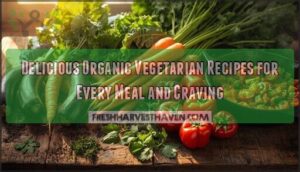This site is supported by our readers. We may earn a commission, at no cost to you, if you purchase through links.

If you’ve ever noticed how a bowl of roasted vegetables can lift your mood, you’re onto something bigger than taste. Researchers have found that people who eat more vegetables tend to live longer, with lower rates of heart disease and diabetes.
But the real magic of healthy vegetable-based meals goes beyond numbers—think of the crunch of fresh broccoli, the deep green of sautéed spinach, the comfort in a steaming lentil stew. It’s about flavor, nourishment, and feeling good in your own skin.
There’s a world of easy ways to bring more veggies to your table, and you don’t have to sacrifice satisfaction or simplicity.
Table Of Contents
- Key Takeaways
- Benefits of Vegetable-Based Meals
- Easy and Flavorful Vegetable Dinner Ideas
- High-Protein Vegetable-Based Recipes
- Global Inspirations for Vegetable Meals
- Tips for Planning Healthy Veggie Meals
- Frequently Asked Questions (FAQs)
- What is the healthiest vegetarian meal?
- What is the best veg dinner for weight loss?
- What is the best vegetable to eat for dinner?
- How do I start cooking vegetables if Im a complete beginner?
- What kitchen tools are essential for vegetable meal preparation?
- How can I make vegetables taste better for picky eaters?
- Which vegetables are cheapest and most nutritious year-round?
- How do I store fresh vegetables to maximize shelf life?
- How can I make vegetables appealing to kids?
- Which vegetables are best for picky eaters?
- Conclusion
Key Takeaways
- Eating a variety of vegetables boosts your long-term health by lowering risks for heart disease, diabetes, and some cancers.
- Fiber and antioxidants in veggies help keep your gut happy and support your body’s ability to handle stress.
- Easy meal ideas like one-pan dinners, stir-fries, and hearty salads make it simple to enjoy more vegetables without sacrificing flavor or convenience.
- Planning with seasonal produce, smart meal prep, and creative protein sources turns vegetable-based meals into satisfying, nutritious options for any lifestyle.
Benefits of Vegetable-Based Meals
Eating more vegetables does a lot more than just fill your plate with color. You’ll find real benefits for your body and long-term health.
Here’s what makes veggie-based meals such a smart choice.
Nutritional Value and Key Micronutrients
Think of vegetables as your body’s toolbox for healthy eating—they’re packed with nutrient density and key mineral contributions. Spinach, kale, and broccoli shine with vitamin bioavailability, but watch for micronutrient gaps like B12 and iron. To get the most from whole food, aim for intake recommendations and mix up your nutritious food choices with every healthy meal.
As a guide, consider powerhouse fruits and vegetables for peak nutrition.
- Spinach gives you 39% of daily folate per serving
- Kale delivers nearly nine times your vitamin K needs
- Broccoli offers almost half your vitamin C in 100g
Fiber and Antioxidant Advantages
Now, let’s talk about fiber and antioxidants—two heroes in healthy vegetable recipes. Veggies like broccoli and beans boost fiber digestion, keeping your gut microbiome happy and hunger in check. Antioxidant synergy from foods like kale and red pepper aids metabolic health, helping your body fight off stress.
Some vegetables are also rich in prebiotics, which feed beneficial gut bacteria. That’s why flavorful vegetable dishes are so important for disease prevention.
Role in Preventing Chronic Diseases
When you fill your plate with healthy vegetable recipes, you’re building a strong shield against chronic diseases. For example, regular vegetable meals help lower CVD risk, support diabetes prevention, and aid cancer mitigation. Here’s how healthy eating habits make a difference:
Healthy vegetable recipes build a strong defense against chronic diseases like heart disease, diabetes, and cancer
- CVD risk reduction
- Diabetes prevention
- Cancer mitigation
- Hypertension prevention
These healthy meals truly benefit population health.
Easy and Flavorful Vegetable Dinner Ideas
If you’re looking for easy ways to enjoy vegetables at dinnertime, you’re in the right spot. There’s no need for complicated prep or bland flavors.
Here are some simple, tasty options you can try tonight.
One-Pan and Sheet-Pan Vegetable Meals
Ever wondered why onepan dinner solutions keep popping up in vegetable recipes? Sheet-pan and onepan meals pack roasted vegetables, cooking efficiency, and ingredient diversity into every bite. You get a full serving of veggies, minimal cleanup, and adaptable flavors.
Their popularity isn’t just hype—these dishes boost dietary impact and health outcomes, making vegetable-based dinners easy, nutritious, and satisfying for busy families.
Quick Stir-Fries and Sautéed Dishes
Across kitchens worldwide, quick meals like stir-fry vegetables and sautéed vegetables are winning hearts for their short prep time and high nutrient retention. Global trends show more families turning to these easy recipes for dinner. Here’s how to make the most of them:
- Use colorful veggies
- Choose healthy oils
- Watch caloric variation
- Enjoy cooking impact
Comfort Food With a Plant-Based Twist
Nostalgia finds new meaning in comfort food recipes that use Plant-Based Swaps for Healthy Indulgence. You can enjoy Vegan Nostalgia with dishes like crispy orange cauliflower or broccoli melts—classic flavors, comfort reinvented.
Global Flavors add excitement, turning vegetarian comfort food into plantbased meal options that satisfy. These vegetarian dinner ideas make plantbased meals both familiar and fresh.
High-Protein Vegetable-Based Recipes
Getting enough protein from veggie meals is easier than you might think. There are plenty of tasty ways to pack more protein into your plate.
Let’s look at some hearty recipes that make vegetables the star and keep you feeling full.
Tofu, Beans, and Lentil-Based Meals
Hungry for something that loves you back? Tofu, beans, and lentils lay the foundation for plant-based protein you can count on.
With tofu’s versatility, the bean benefits, and lentil recipes like lentil vegetable soup, you get easy meals packed with dietary fiber and iron.
Tofu-based recipes and hearty stews help you stay full—without missing out on flavor or nutrition.
Creative Ways to Add Protein to Veggie Dishes
Think of protein like the anchor in your plant-based plate. Boost vegetarian recipes by tossing in quinoa or chickpea pasta for a fiber and protein combo.
Sprinkle hemp seeds or almonds for a nutty crunch; swirl in fermented legumes for extra nutrition.
Mixing grains and beans, layering nuts, and using plant-based products turn veggie dishes into satisfying high-protein meals.
Filling Salads and Skillets
Ever wonder why some salads and skillets actually keep you satisfied? Fiber-packed salad recipes and high-protein skillet ingredients anchor these easy, healthy recipes. Get the most out of each meal with:
- Lentil-based vegetarian recipes
- Tofu or bean protein additions
- Colorful, global flavors
- Creative Salad Meal Prep
- Smart waste reduction strategies
Healthy recipes start with quality vegetable recipes and practical prep.
Global Inspirations for Vegetable Meals
Vegetable meals shine in every corner of the world, each culture adding its own flavor and twist. If you’re hungry for variety, trying recipes inspired by global kitchens keeps things fresh and exciting.
Here are a few ideas to help you mix up your routine.
Mediterranean and Italian-Inspired Recipes
Why do Mediterranean and Italian recipes make veggies taste so good? It’s all about olive oil benefits, flavorful herbs, and clever pasta alternatives. Picture roasted zucchini, tomato-rich puttanesca, or Caponata—each dish celebrates regional variations and pairs beautifully with wine.
These recipes pack nutrition, keep cholesterol low, and turn humble veggies into memorable meals you’ll crave again and again.
Asian and Latin American Vegetable Dishes
If you’re craving bold, veggie-packed recipes, Asian and Latin American kitchens offer flavorful dishes that make cooking vegetables feel like a celebration. Try these:
- Soy benefits shine in tofu stir-fries and edamame snacks.
- Bitter gourd and cabbage uses boost fiber and blood sugar control.
- Plantains and squash garlic sautés add comfort and vibrant nutrition to vegetarian recipes.
Modern Plant-Based Takes on World Classics
If you love vegetarian dinners or vegan recipes with a worldly twist, you’re in good company. Culinary adaptation is everywhere—plant-based versions of classics like lasagna and burgers are winning hearts.
Thanks to strong cultural acceptance and a booming global market, these meals offer lighter nutritional profiles and a smaller environmental impact, making plant-based cooking a smart, satisfying choice for modern home cooks.
Tips for Planning Healthy Veggie Meals
Planning veggie meals can feel tricky, but a few smart habits make it much easier. You’ll find that a little thought up front helps you eat healthier all week.
Here are some practical ways to get started.
Incorporating Seasonal and Local Produce
With seasonal eating, you get vegetables at their peak ripeness—full of flavor and nutrients. Local sourcing isn’t just fresher; it aids your community and cuts down on emissions.
For healthy eating, try easy recipes featuring seasonal produce from farmers’ markets. You’ll notice:
- Brighter colors and flavors
- A boost in nutrition
- A stronger connection to your local economy
Meal Prep Strategies for Busy Schedules
Getting fresh veggies is just the start—batch cooking and smart meal prep make healthy eating possible, even on your busiest weeks.
For instance, prepping grains, beans, and veggies ahead saves you hours. Use labeled containers and plan quick and easy recipes that keep their flavor.
These time-saving techniques help you eat well, reduce stress, and stick to your goals.
Reducing Food Waste and Maximizing Nutrition
Reducing waste starts with smart Storage Best Practices—think crisp veggies, clear labels, and quick access. Portion Control helps you serve just what’s needed, while Recipe Repurposing turns leftovers into easy recipes.
Embracing Sustainable Sourcing and Composting Solutions keeps your kitchen eco-friendly. With these habits, vegetarian dinners become a celebration of healthy eating and efficient vegetarian cooking.
Frequently Asked Questions (FAQs)
What is the healthiest vegetarian meal?
Ever wonder what really packs a punch for health on your plate? A bowl with quinoa, black beans, roasted veggies, avocado, and pumpkin seeds offers complete proteins, micronutrient balance, recipe optimization, and hearty variety—all hallmarks of healthy vegetarian meals.
What is the best veg dinner for weight loss?
For veggie weight loss, go for a one-pan stir-fry with broccoli, tofu, and colorful peppers. It’s high in fiber, protein-packed, low-calorie, and fits plant based diets—one of my favorite healthy dinner ideas that’s both filling and delicious.
What is the best vegetable to eat for dinner?
As the saying goes, “Variety is the spice of life.” For dinner, broccoli stands out for Veggie Nutrition—rich in vitamin C and K. Pair it with cauliflower, spinach, or asparagus for balanced Dinner Ideas and Healthy Eating.
How do I start cooking vegetables if Im a complete beginner?
Start by gathering Kitchen Essentials—a sharp knife, cutting board, and sturdy sheet pan.
Focus on Basic Cooking Techniques like roasted vegetable preparation or sautéed vegetable techniques.
Try stir fry vegetable recipes for easy side dish recipes and simple Vegetable Prep.
What kitchen tools are essential for vegetable meal preparation?
Having the right kitchen tools is like having a toolbox for flavor. Chef Knives, Cutting Boards, Vegetable Slicers, Blenders, and Steamers all simplify vegetable preparation, making cooking methods like roasted, sautéed, or stir-fry vegetable recipes much easier.
How can I make vegetables taste better for picky eaters?
Picky eaters warm up to vegetables when you use flavor enhancement, like adding dips or roasting for sweetness. Play with meal presentation, creative shapes, and taste modification techniques.
Cooking vegetables at home—especially using easy vegan recipes—boosts acceptance and enjoyment.
Which vegetables are cheapest and most nutritious year-round?
For cost-effective eating and year-round nutrition, you can’t go wrong with budget-friendly vegetables like broccoli, cabbage, carrots, onions, potatoes, and sweet potatoes.
These flavorful vegetables boost nutrients, support affordable recipes, and make vegetarian and vegan cooking a breeze.
How do I store fresh vegetables to maximize shelf life?
To keep vegetables fresh, store them at the right temperature, use ethylene separation for sensitive produce, choose packaging methods like perforated bags, and rinse with proper washing techniques—these meal prep tips all support healthy eating and waste reduction.
How can I make vegetables appealing to kids?
Funny enough, what kids see is what they crave. Parental Modeling, Choice Control, tasty dips, and playful Food Presentation—like veggie animals—can turn healthy eating, vegetarian meal ideas, and easy recipes into vegetables your family actually loves.
Which vegetables are best for picky eaters?
Carrots, sweet bell peppers, cucumbers, and sweet corn top the list for picky eaters. Their mild flavors, crunchy textures, and visual appeal make them easy vegetarian options—especially when paired with repeated exposure and positive parental influence.
Conclusion
Imagine your plate as a vibrant garden—each bite a seed planted for your well-being. Healthy vegetable-based meals aren’t just fuel; they’re a daily act of self-care, connecting you to flavors from every corner of the world.
When you choose colorful veggies, you’re building strength, resilience, and comfort, bite by bite. Let your kitchen become a place where good choices grow naturally, and every meal reminds you that nourishing yourself can be simple, satisfying, and joyful.
- https://foodstruct.com/food/vegetable
- https://www.ncbi.nlm.nih.gov/books/NBK588715/
- http://www.ers.usda.gov/amber-waves/2024/september/satisfying-fruit-and-vegetable-recommendations-possible-for-under-3-a-day-data-analysis-shows
- https://pmc.ncbi.nlm.nih.gov/articles/PMC7912826/
- https://www.nature.com/articles/s41538-024-00362-y









